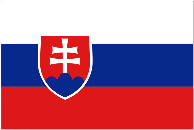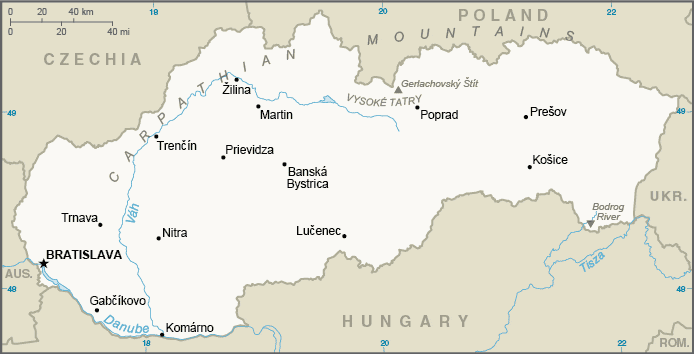Table of Contents
| Location and Size | Credit and Collections |
| Government | Risk Assessment |
| Legal System | Business Climate |
| People | Business Protocol |
| Economy | |
| Comparative Indicators |
12345
Location and Size
The Slovak Republic is a landlocked country in Central Europe, bordering Austria, the Czech Republic, Hungary, Poland and the Ukraine. Covering an area of 49,035 sq. km., it is about half the size of the state of Maine or twice the size of New Hampshire.
Government
The Slovak Republic was established on January 1, 1993 and includes 8 regions. It was formerly part of the Czechoslovak Republic established in 1918.
Branches:
- Executive: Chief of state President Zuzana Caputova; head of government Prime Minister Eduard Heger; and four Deputy Prime Ministers Richard Sulik, Igor Matovic, Stefan Holy, Veronika Remisova
- Legislative: Unicameral National Council including 150 seats with members elected by proportional representation to serve four-year terms.
- Judicial: Supreme Court (judges elected by the National Council); Constitutional Court (judges appointed by president from nominees approved by the National Council); Special Court (judges elected by a council of judges and appointed by the president.
Legal System
Slovakia’s legal system is a civil law system based on Austro-Hungarian codes.
The Slovak judicial system is comprised of general courts and the Constitutional Court. General courts decide in civil and criminal matters and review the lawfulness of decisions by administrative bodies.
People
- Population: 5,436,066
- Population growth rate: 0.1%
- Languages: Slovak (official). Hungarian, Roma, and Ruthenian are official minority languages.
- Literacy: 99.62%
- Ethnic Make-up: Slovak 80.7%, Hungarian 8.5%, Romani 2%, Other 8.8%
- Religions: Roman Catholic 62%, Protestant 8.2%, Greek Catholic 3.8%, unaffiliated or other 25.9%
Economy
Slovakia has a mixed economic system in which there is a variety of private freedom, combined with centralized economic planning and government regulation. The country made significant economic reforms after its separation from the Czech Republic in 1993. However, the economy contracted 5% in 2009 primarily as a result of smaller inflows of FDI and reduced demand for Slovakia’s exports.
Leading Markets (2021): Germany 20.7%, Czech Republic 11.6%, Poland 7.7%, France 6.3%, Italy 6.1%, UK 6.0%, Hungary 6.0%, Austria 6.0%
Leading Exports – Commodities: Vehicles and related parts 27.0%, machinery and electrical equipment 20.0%, nuclear reactors and furnaces 12.0%, mineral oils and fuels 5.0%, iron and steel 4.0%
Leading Suppliers (2021): Germany 19.1%, Czech Republic 16.3%, Austria 10.3%, Poland 6.5%, Hungary 6.4%, South Korea 4.5%, Russia 4.5%, France 4.3%, China 4.2%
Leading Imports – Commodities: Machinery and transport equipment 31%, mineral products 13%, vehicles 12%, base metals 9%, chemicals 8%, plastics 6%
Top Industries: Metal and metal products; food and beverages; electricity, gas, coke, oil, nuclear fuel; chemicals and man-made fibers; machinery; paper and printing; earthenware and ceramics; transport vehicles; textiles; electrical and optical apparatus; rubber products
Top Agricultural Products: Grains, potatoes, sugar beets, hops, fruit; pigs, cattle, poultry; forest products
Comparative Economic Indicators – 2021
| Slovakia | Austria | Czech Republic | Hungary | Poland | Ukraine | |
| Population* (millions) | 5.4 | 8.7 | 10.6 | 9.8 | 38.4 | 43.9 |
| Population growth rate* (%) | -0.02 | 0.42 | 0.1 | -0.26 | -0.16 | 0.04 |
|
Age Structure (%)
(15 to 64 years old)
|
68.84 | 66.57 | 65.37 | 65.84 | 67.73 | 58.56 |
|
Age Structure (%)
(65+ years old)
|
15.97 | 19.44 | 19.42 | 19.5 | 17.47 | 16.49 |
| Literacy (%) | 99.62 | 99 | 99.83 | 99.1 | 98.74 | 99.97 |
| Unemployment Rate (%) | 8.1 | 5.5 | 2.9 | 4.2 | 4.9 | 9.2 |
| Inflation (%) | 1.3 | 2.2 | 2.4 | 2.4 | 2.0 | 14.4 |
| Population below poverty line (%) | 12.3 | 3.0 | 9.7 | 14.9 | 17.6 | 3.8 |
| GDP real growth rate (%) | 3.4 | 3.0 | 4.3 | 4.0 | 4.7 | 4.7 |
| GDP per capita** | 33,100 | 50,000 | 35,500 | 29,600 | 29,600 | 8,800 |
| Public debt (% of GDP) | 50.9 | 78.6 | 34.7 | 73.6 | 50.6 | 71.0 |
| Exports (USD billions) | 80.8 | 156.7 | 144.8 | 98.7 | 224.6 | 39.69 |
| Imports (USD billions) | 80.07 | 158.1 | 134.7 | 96.3 | 223.8 | 49.06 |
| Reserves of foreign exchange and gold (USD billions) | 3.62 | 21.57 | 128.0 | 28.0 | 113.3 | 18.81 |
| Currency | Euro (EUR) |
Euro (EUR) |
Koruna (CZK) |
Forint (HUF) |
Zloty (PLN) |
Hryvnia (UAH) |
| Exchange rates (per USD) 02/11/2022 | 0.90 | 0.90 | 23.29 | 297.10 | 3.94 | 25.16 |
| Exchange rates (per EUR) 02/11/2012 | n/a | n/a | 25.84 | 329.53 | 4.38 | 27.91 |
* 2021 estimates
** PPP ” Purchasing Power Parity
Credit and Collections
Most business relationships are regulated by the Slovak Commercial Code and Slovak Civil Code.
The interest rate to be charged upon payment default should be specified between the supplier and buyer. If not specified, the legal interest rate is that determined by the European Central Bank plus eight percentage points.
Risk Assessment
Coface Country Rating: A3 – A basically secure business environment can nonetheless give rise to occasional difficulties for companies. Corporate default probability is quite acceptable on average.
Coface Business Climate Rating: A2 – The political and economic situation is good. A basically stable and efficient business environment nonetheless leaves room for improvement. Corporate default probability is low on average.
Business Climate
Market Access: Slovakia is a member of the European Union. It is also a member of the European Economic Area (EEA) which has guaranteed, since January 1, 1993, the free movement of most goods between the European countries. In addition, Slovakia has multilateral and bilateral agreements with other countries including the United States.
Economic Freedom: Slovakia’s economic freedom score is 65.0, making its economy the 65th freest in the 2021 Index of Economic Freedom. Slovakia is ranked 32nd out of 44 countries in the European region, and its overall score is higher than the world average. However, economic freedom peaked in 2008 and has been on a downward trend ever since. Prospects for long-term economic development have been curtailed by the government’s ineffectiveness against corruption and lack of political commitment to enhancing Slovakia’s legal framework. Government spending has been increasing, and privatization of many remaining state assets has been suspended.
Regulatory System: Foreign investors and foreign companies doing business in Slovakia have complained about the transparency of regulatory processes in several industries.
Intellectual Property Rights: Protection of intellectual property rights (IPR) falls under the jurisdiction of two agencies. The Industrial Property Office is responsible for most areas, including patents, and the Ministry of Culture is responsible for copyrights (including software). Slovakia is a member of the World Trade Organization (WTO), the European Patent Organization (EPO) and the World Intellectual Property Organization (WIPO).
Exchange Control: Foreign exchange operations in Slovakia allow easy conversion or transfer of funds associated with an investment. As a member of the OECD, Slovakia meets all of the international standards for conversion and transfer policy. Slovaks are free to trade, buy and sell foreign securities and there are very few controls on capital transactions.
Corruption: The business community considers corruption and political influence to be significant problems within the Slovak legal system. U.S. and other companies have reported to their embassies instances of multi-million dollar losses that were settled out of court because of doubts about the court system’s ability to offer a credible legal remedy.
Political Violence: There have been no reports of politically motivated damage to property, and civil disturbances are extremely rare. There has been no violence directed toward foreign-owned companies.
Business Protocol
Slovak business-people initially take a formal and distant approach to people in business. Be prepared for a seemingly cold reception at first. However, the younger generation involved in business are willing to dispense with protocol and use a slightly more relaxed level of formality.
First names are seldom used in business.
Business cards: It’s a good idea to have one side of your business card printed in Slovak. You should also include the length of time your firm has been in business, if more than 20 years, and any advanced university degrees you have obtained.
In general, meetings are conducted by the most senior person present, who sets the agenda, the content, and the pace. The purpose is usually to communicate information and decisions that have already been made, not to brainstorm or discuss. Employees may be called on to corroborate or clarify facts and statistics, but will not usually be asked to collaborate.
More information on Business Protocol: Kwintessential
**********
Subscribe to the Credit-to-Cash Advisor
Monthly e-Newsletter — It’s Free
This information is provided by ABC-Amega Inc. Providing international receivable management and debt collection services for exporters to more than 200 countries. For further information, contact [email protected].
Historical Exchange Rates: OANDA.com The Currency Site.

